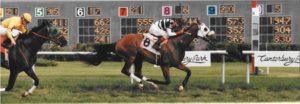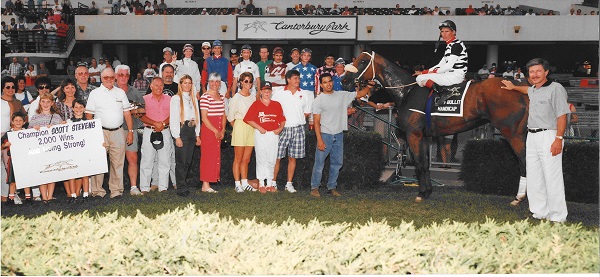By Noah Joseph
When Canterbury Downs closed its doors following the 1992 season, the owners, trainers, jockeys, and horses all left to continue elsewhere, as no one knew if racing would ever return to Minnesota. When it did return in 1995, many of the people came back, but not many of the horses. However, some did return, and one of them helped Canterbury usher in a new era. That horse was Doc Hollywood.
Doc Hollywood was bred in Kentucky by Frank Jedlicki, who also co-owned the horse along with Kim Jedlicki. He was sired by Executive Order out of a mare named Cerigo. With a humble pedigree like that, Doc Hollywood was considered to be just a regular racehorse, but sure enough, he made it to the races as a two-year-old at Canterbury. He made his debut on August 28, 1992, in a maiden race, where he finished a dull sixth behind Irish Moment, who would go on to finish third in the Northern Lights Debutante just a couple of weeks later. That maiden race, however, would be Doc Hollywood’s lone start at two, as he did not return to the races until July of 1993, and by that time, Canterbury had gone dark. So now he was in Kentucky, and early on it looked like he might thrive there, as he broke his maiden at Ellis Park at 22-1. That would be his only bright spot in the bluegrass state. He was able to compete at the big tracks in Kentucky like Churchill Downs and Keeneland, he was just never good enough to get over the hump. After not running at all in 1994, 1995 was looking like a disappointing year for Doc Hollywood. So how do you get out of a slump? Perhaps going back to where it all began might help.
When Canterbury reopened in 1995, the Jedlickis brought Doc Hollywood back to Minnesota, and right from the get go, he started to look like a new horse. He was running better, and he was also winning races, something he hadn’t done in almost two years. Doc Hollywood won his first two starts at Canterbury, both of them on the grass, and was ridden in both victories by Scott Stevens, who became Doc Hollywood’s regular Canterbury pilot. After a quick trip to Chicago where he won again, Doc Hollywood then ran in the Minnesota Turf Championship Handicap, his first ever stakes race. And while he finished a tough luck second to eventual Hall of Famer Little Bro Lantis, this race would become a major point in Doc Hollywood’s career trajectory. Following that race, Doc Hollywood went to Oklahoma and won his first career stakes race and started to show that he could be more than just an average runner. That year ended with the promise of greater things to come.
 In 1996, Doc Hollywood returned to Canterbury looking to build on of his strong season the year before. However, his Canterbury campaign could not have gotten off to a worse start, as he finished seventh in the Renville County Handicap as the beaten favorite behind Who’s John Galt. Was it possible that he was nothing more than a one-year wonder? His connections had faith and they took their time with him. After another quick stop in Chicago, Doc Hollywood was then entered in the inaugural John Bullit Handicap. He was given a solid chance to win, he would have to defeat the likes of Little Bro Lantis and Who’s John Galt in the one mile turf contest. At odds of 6-1, Doc Hollywood tracked the leaders, then swung three-wide into the stretch and rallied to win by a length for the Jedlickis and trainer Steve Asmussen. This win was extra special for jockey Scott Stevens, who in the process of guiding Doc Hollywood to victory, won his 2,000th career race. Stevens would ride Doc Hollywood one more time in the Boyer Ford Truck Turf Handicap, where he would finish second in a game effort. Doc Hollywood made his final start in Chicago later that year.
In 1996, Doc Hollywood returned to Canterbury looking to build on of his strong season the year before. However, his Canterbury campaign could not have gotten off to a worse start, as he finished seventh in the Renville County Handicap as the beaten favorite behind Who’s John Galt. Was it possible that he was nothing more than a one-year wonder? His connections had faith and they took their time with him. After another quick stop in Chicago, Doc Hollywood was then entered in the inaugural John Bullit Handicap. He was given a solid chance to win, he would have to defeat the likes of Little Bro Lantis and Who’s John Galt in the one mile turf contest. At odds of 6-1, Doc Hollywood tracked the leaders, then swung three-wide into the stretch and rallied to win by a length for the Jedlickis and trainer Steve Asmussen. This win was extra special for jockey Scott Stevens, who in the process of guiding Doc Hollywood to victory, won his 2,000th career race. Stevens would ride Doc Hollywood one more time in the Boyer Ford Truck Turf Handicap, where he would finish second in a game effort. Doc Hollywood made his final start in Chicago later that year.
While Doc Hollywood may not be the most well-recognized horse in Canterbury legend, his success was vital in helping the track get back to a high-quality level of racing and helped pave the way for some of Canterbury’s best runners today. Doc Hollywood has certainly cemented his place in Canterbury history.
